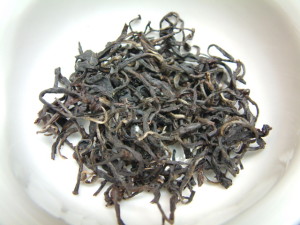There are a number of teas that might be considered staples today including Masala Chai, Lapsang Souchong or Earl Grey tea. One of the best known of these “staple” teas is English Breakfast Tea, a bold, eye opening tea that many turn to for that first cup of the morning. However, English Breakfast Tea isn’t a consistent blend and has somewhat cloudy history like many other tea.
English Breakfast Tea History

English Breakfast Tea was rumored to have been “invented” near Wall St in the 1800’s. [by George Bradford Brainard – Public Domain]
From another corner of commerce in the 1800’s comes Robert M. Walsh, author of Tea, It’s History & Mystery, Tea Blending as a Fine Art, and A Cup of Tea. The last of these publications, circa 1884, suggests that English Breakfast was really Chinese Bohea tea; an oolong or black tea produced in the Bohea hills of northern Fujian Province in China. He speaks of Bohea tea as “a distinct variety, differing in color, liquor, and flavor from the Oolong species, and known to trade in this country [United States] as “English Breakfast” tea, from its forming the staple shipment to England.”
Then there is the Anhui Tourism Administration which states that Keemun was produced by a failed civil servant who sought to bring black tea manufacturing from Fujian to Anhui which had previously only produced green tea. According to the website the result was so good that it quickly gained popularity in England and became the prominent base to English Breakfast Tea.
We are great believers that the truth to most stories is likely somewhere in between. In this case it is likely that what we know as English Breakfast was already enjoyed elsewhere before it was “invented” and marketed to an eager consumer.
English Breakfast Tea Blends
Today English Breakfast Tea is typically a blend of black teas from Assam, Sri Lanka, and Kenya. Although this is not a hard and fast rule with many including a Chinese Keemun or other black tea instead. The selection of teas used to make English Breakfast are chosen for the qualities they offer to color, flavor, aroma, and mouth feel. Even if the same teas are used, the ratio of each are bound to be different. The ratio may even be changed from batch to batch to account for subtle differences in one or more of the ingredients. Since tea is an agricultural product the “same” product from the same vendor will have different qualities from year to year. Each blender chooses the combination that gives just the right taste that they have in mind and which they believe will best meet the needs of their customers. Thus, blends vary widely and will almost certainly be different from company to company. So no matter what the blend, if a smooth black tea sounds appealing in the morning, reach for some English Breakfast.
Sources Cited
Daily Alta California, Volume 28, Number 9436, 5 February 1876, Page 4, http://cdnc.ucr.edu/cgi-bin/cdnc?a=d&d=DAC18760205.2.38#
Types of teas in Anhui Province, Qimen Black (Keemun) Tea, China Daily, http://www.chinadaily.com.cn/m/anhui/travel/2010-04/29/content_9791685_2.htm
A Cup of Tea, by Joseph M. Walsh, 1884, pg 108-109, https://archive.org/stream/cu31924023998184#page/n113/mode/2up










